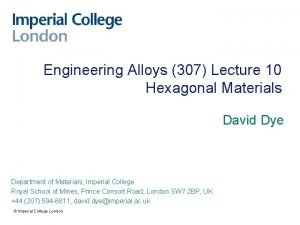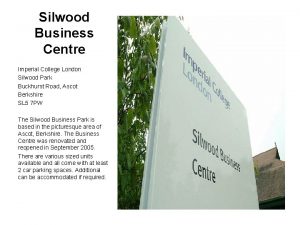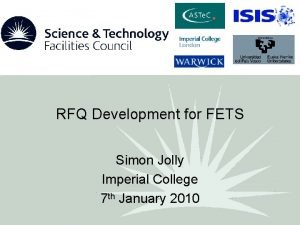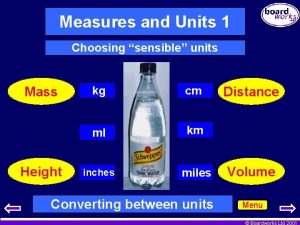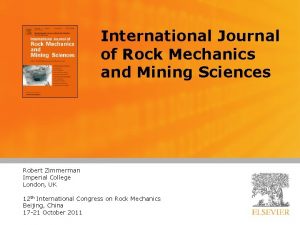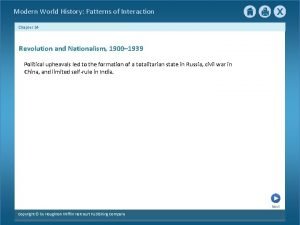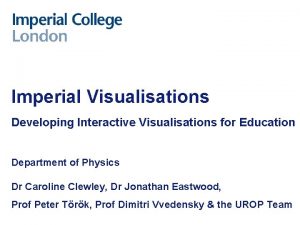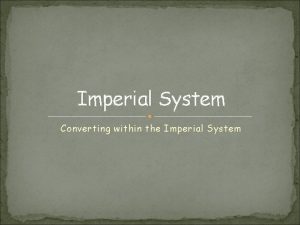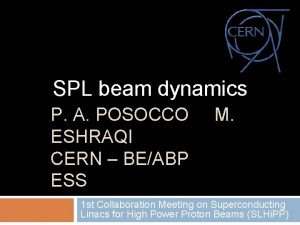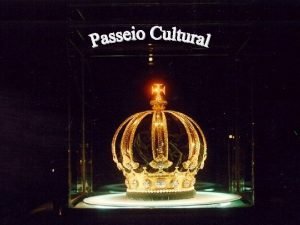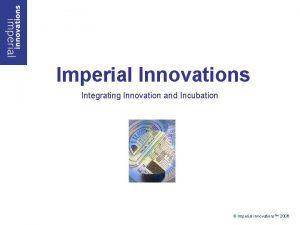DevelopmentsPlans at Imperial P A Posocco Imperial College
















- Slides: 16

Developments/Plans at Imperial P. A. Posocco Imperial College London

P. A. Posocco - PASI Meeting 04/04/2013 Article from NZZ, published on Jan 16 th 2013 Cost factor: The price of proton therapy is 22. 5 higher than photons, But This price is compatible with the newest Antibodies medicines And The price does not take into consideration morbidity and tissue sparing capabilities. 2

P. A. Posocco - PASI Meeting 04/04/2013 Article from NZZ, published on Jan 16 th 2013 5 years survival rate: Cartilaginous tumors: 40% 80% Bone tumors: 5% 50% Pediatric cases: Lower integral dose = reducing growth problems But No statistics about more “standard” tumors (breast, lung, abdomen) 3

P. A. Posocco - PASI Meeting 04/04/2013 Article from NZZ, published on Jan 16 th 2013 Problems / questions: - Moving targets - Protons or heavier ions? Situation in Germany - Two Siemens centers in Marburg and Kiel were cancelled at medium or advanced stage - Their business model was based on 2, 500 patients p. a. but recent studies showed that not more than 1, 000 could be treated 4

P. A. Posocco - PASI Meeting 04/04/2013 Extract from Dr H. Nystrom’s talk at the PSI Winter School Getting a proton center using the European tendering system can be quite troublesome Vendors realized that they can make a lot of money with these centers and they have become quite aggressive Where and when did the importance of the research on proton therapy come into play? 5

P. A. Posocco - PASI Meeting 04/04/2013 From http: //www. proton-therapy. org/map. htm The Willis-Knighton Medical Centre in Shreveport Louisiana is getting an IBA Proteus®ONE, paid cash (no loans), to be operated like a (more expensive) photon machine (long hours and including more “standard” tumors = increased efficiency) 6

P. A. Posocco - PASI Meeting 04/04/2013 Questions (provocative) Where does research become important? In Europe we treat patients still on a semi-research basis and we think of improving technologies to increase the number of centers (mainly reducing their costs) In the US they intend to treat patients as PBT were a standard care and, apparently, the don’t mind about its costs Is research driven by the type of healthcare system? If so, why doesn’t the national healthcare itself push (and pay) for the research on new technologies? Is it because they are not really convinced about PBT? Manufacturers are offering turnkey solutions, implying a high dose of (internal) standardization. Are we, public funded researchers and limited in number, able to provide the same service? Is it possible to develop new technologies for proton therapy without having access to the daily routine of a proton therapy center? 7

P. A. Posocco - PASI Meeting 04/04/2013 Answers (simple or simplistic) 1. Starting from scratch to see whether PBT has more advantages than just a better 3 D dose painting over photon therapy 2. Take the most advanced (but reliable) technologies developed for the noble physics and see whether they can be adapted for the specific use of PBT (in a hospital environment) 3. Create a new generation of physicists able to think directly about PBT without going through the “knowledge transfer” mental process 8

P. A. Posocco - PASI Meeting 04/04/2013 Consequently at Imperial… We are setting up a multidisciplinary team (Physics, Biology, Chemistry) to investigate Radiation Biology mechanisms We are using in-house expertise (and excellence) to work on laser-plasma accelerators and FFAG gantries for a new generation of medical machines We are advertising our activities on PBT starting from the bottom, the undergraduate summer student program We are committed to initiate and maintain contacts with the industry (especially with those manufactures which at the moment don’t belong to the PBT community) We will participate and contribute to those conferences, workshops etc. organized by our counterpart, the medics 9

P. A. Posocco - PASI Meeting 04/04/2013 Radiobiology (1/2) Radio Biological Effectiveness (RBE): The ratio of the dose of X-rays of a certain energy that will produce a specified biological effect to the dose of another radiation required to produce the same effect Spread out Bragg Peak (SOBP): Possible effect of the RBE on dose prescription Figure 6 from Range uncertainty in proton therapy due to variable biological effectiveness Alejandro Carabe et al 2012 Phys. Med. Biol. 57 1159 10

P. A. Posocco - PASI Meeting 04/04/2013 Radiobiology (2/2) Why don’t we turn protons’ or heavier ions dose delivery even more to our advantage? Nanoparticle in a cell www. nanoparticles. org 1. Carriers: nanoparticles 2. Bonds: synthetic DNA strands to link or wrap drugs or other sensitizers 3. Drug selective release due to DNA breaks 11

P. A. Posocco - PASI Meeting 04/04/2013 Proof of Principle Gabor lenses A Po. P setup for energies in the range up to 30 Me. V will be proposed in the near future. The experiments could be preformed in 3 phases : 1: one lens (“ 3”) , no aperture, particle capture 2 : two lenses (shown), aperture, reduced energy spread, energy selection up to ~10 Me. V 3 : three lenses & aperture, Energy selection up to 30 Me. V 12

P. A. Posocco - PASI Meeting 04/04/2013 A. Koschik et al. “The Medaustron proton gantry” IPAC 12 - THPPR 052 PSI Design R. Fenning et al. “A non-scaling FFAG gantry design for the PAMELA project” IPAC 10 - THPE 034 STFC Design D. Trbojevic “Innovative superconducting non-scaling fixed FFAG isocentric gantry for Carbon cancer therapy” IPAC 11 - WEPS 029 BNL Design 13

P. A. Posocco - PASI Meeting 04/04/2013 4 UROP topics at Imperial Laser-plasma ion accelerators: reconstruction of a beam distribution Ion Accelerators based on laser-plasma technology represent a, possibly unique, way of obtaining ion beams at medium energy (~50 Me. V) with a very compact device. The development of this technology could bring in the near future multi-purpose particle accelerators, which will be employed, for example, in industry or medicine. The beam is created in pulses, and the ions show a strong correlation between transverse position, energy and time within the pulse itself. The design of such beam lines able to focus and transport this peculiar beam to its final users is one of the big challenges the accelerator physicists have to face in order to establish the laser-plasma technology as a sensible alternative to conventional accelerators. The first step is therefore the definition of a 3 D time dependant distribution of particles right after the source, ready to be transported through the beam line. Measurements of an actual beam distribution have been carried out recently within the collaboration LIBRA, and the Candidate has the task to create a particle distribution based on these data and to write it in a format that can be employed by the beam transport codes in use in the Group. This distribution will become the new reference distribution for optimisation studies of the beam line, taking the place of the code generated beam distribution used so far. Proton Therapy (PT) is a well-established cancer treatment, which helped more than 10’ 000 patients in the world only in the last year. It is based on the concept of delivering energy to the tumour using a proton beam (70 -250 Me. V) as a carrier instead of electrons or x-rays. The outcomes are very positive and for most of patients PT can give much better results in terms of morbidity and tumour control than conventional Radio Therapy. The understanding of the interaction between protons and cells is fundamental to fully exploit the superior conformal energy deposition of protons and therefore in-vitro experiments are required. However, at the sub-microscopic level it is quite a challenge to measure with enough precision the energy protons release in the cell, and that represents a serious burden for the facilities dealing with experiments of this kind, in terms both of detectors and beam delivery techniques. Comparative studies on protons and x-rays effect to cells must be carried out normalising the energy deposition, but the techniques involved and the environments where the measurements are taken differ in the two cases. The Candidate will explore critically the options provided by the centres operating with protons in this field and will help compiling a list of desiderata for the next facilities. Shooting cells with protons: a rigorous dosimetric approach The deposition of energy inside the body: the spatially-weighted proton Bragg peak Fixed Field Alternating Gradient (FFAG) Medical Gantries: development of a friendly simulation code FFAG type beam lines have the advantage over conventional beam lines of being energy invariant; in other words, beams with different energies can be transported maintaining the same characteristics without tuning the magnetic elements of the line itself. This is extremely convenient when you have to switch rapidly the beam energy or when the beam quality assurance for different energies is a must, which is the case, for example, for the accelerators employed by Proton Therapy. Accelerators based on this technology have started to operate in the UK and Japan, however the magnetic configuration of the elements of the line is more complicated than for conventional lines. It represents a big challenge both for the technologies employed in the design and fabrication of such magnets and for the simulation with conventional codes of the beam transport through them. The Candidate will work on the definition of new magnetic elements for the libraries of the simulation codes currently in use in the group, and, ideally, will prepare a userfriendly interface able to facilitate the integration of those elements in the simulations workflow. Charged ions slow down while travelling through the matter. The energy loss per unit length is the highest close to the end of their journey, when their energy is low. This creates a peak in the energy loss distribution along the ions path, which is named after the English scientist Sir W. H. Bragg. Moreover, the position of this peak can be moved along the path choosing a different initial energy for the ions. This behaviour comes in handy if you want to deliver the maximum energy inside the bulk of the matter and not on its surface, exactly what happens for the cancer treatment called Proton Therapy. In this case though, protons travel through layers of matter with different chemical composition and along their path they can encounter transitions of material within the cross-section of the beam they belong to. If for single protons the Bragg peak is still well defined, for the beam seen as an ensemble of protons going through different materials the Bragg peak becomes blurred, and that might compromise the effectiveness of the treatment. The Candidate will extend to the nonhomogeneities a previous work done on the integration of analytical formulas for the determination of the Bragg peak in homogeneous materials. He will also compute statistically the errors that occur if you misestimate the materials interface. 14

P. A. Posocco - PASI Meeting 04/04/2013 Aim of the topics Laser-plasma ion accelerators: reconstruction of a beam distribution Provide a distribution of macroparticles based on recent measurements in order to validate the simulations carried out for the Po. P Fixed Field Alternating Gradient (FFAG) Medical Gantries: development of a friendly simulation code Optimise a FFAG tracking code for gantries, include the beam sweeping capabilities, interface to treatment planning Shooting cells with protons: a rigorous dosimetric approach Prepare on paper a radiobiology experiment, errors, uncertainties, technologies The deposition of energy inside the body: the spatially-weighted proton Bragg peak Study what happens to the Bragg peak when the beam goes through body interfaces and density variations. Uncertainties in the position or size of the peak 15

P. A. Posocco - PASI Meeting 04/04/2013 Conclusions Before starting to do proper novel research we should: 1. agree with the medics on the week points of the current machines and on the direction to take 2. and, at higher level, on the availability of funding for the research itself Work on basic aspects of PBT which have been historically overlooked Involve more people, create larger collaborations, establish PBT as a sound research field 16
 Imperial college blackboard
Imperial college blackboard Imperial college london
Imperial college london Silwood business centre
Silwood business centre Imperial college
Imperial college Wake tech admissions
Wake tech admissions Early college high school at midland college
Early college high school at midland college Imperial medlearn
Imperial medlearn Governo imperial
Governo imperial Lorraine craig imperial
Lorraine craig imperial Imperial oil mission statement
Imperial oil mission statement Imperial capital vijayanagara
Imperial capital vijayanagara Sensible units
Sensible units Why did the us became an imperial power
Why did the us became an imperial power International journal of rock mechanics and mining sciences
International journal of rock mechanics and mining sciences Chapter 14 section 3 imperial china collapses
Chapter 14 section 3 imperial china collapses Imperial visualisations
Imperial visualisations Imperial measurements
Imperial measurements

